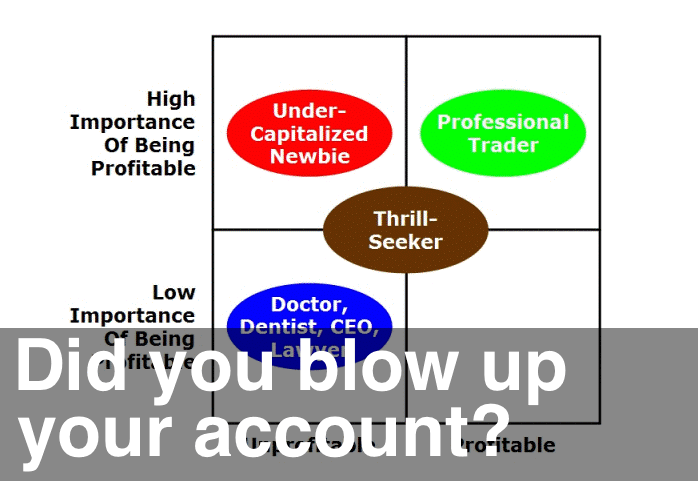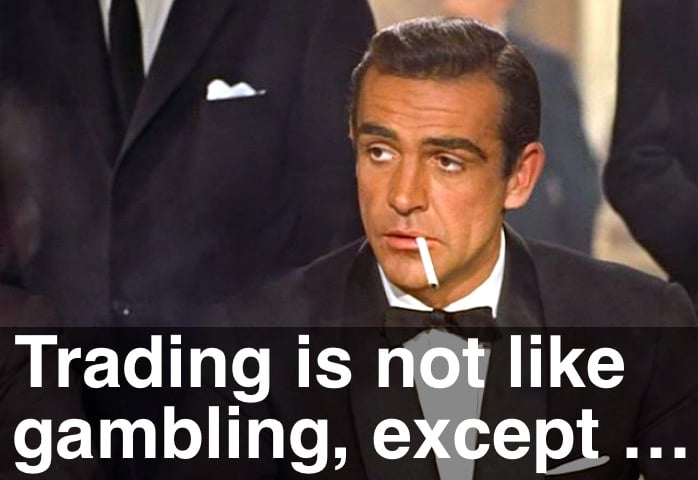
I received a very touching email from a follower, Michael (name changed):
First, thank you very much for your website. I lost my whole account trading the Emini. I’m so upset. I don’t know how I should start again. Please, can you help?
Rather than send Michael a quick response, I thought I might spend some time writing a considered reply and publish it on Emini-Watch. So here goes.
Michael, I would suggest you do three things:
- Ask yourself whether trading really is for you and be brutally honest in your answer
- If trading is for you, then go back through every one of your trades and figure out your mistakes
- Then start again, but “paper trading” only and focussing on fixing your repeat mistakes
In answering the first question, the schematic above might be helpful.
Be honest, is trading really for you?
What type of trader are you? Why do you trade? What is your motivation? In my experience there are 4 types of trader (illustrated in the schematic above):
1. Under-Capitalized Newbies: You’d be surprised how many emails I get from people who have just lost their job, scraped together $5,000 and want to make a living trading. Or attended a broker’s sales presentation showing how easy it is to trade and offering ridiculously low margins. Or just want to buy a high profit-factor trading system and auto-trade it to incredible riches.
These people have no idea what they’re getting themselves into – they are “cannon fodder” for the Professionals. Michael, if you fall into this category and don’t have the stamina to succeed as a trader, then walk away – there are easier ways to make a living, trust me.
2. Doctor, Dentist, CEO, Lawyer: These are generally smart people who are used to being successful. However, when they start trading, all of a sudden they find it’s harder than it looks. The skills that got them to where they are professionally (being smarter than most, being good with customers or colleagues, corporate ladder climbing) don’t mean a thing trading.
But they’ve got deep pockets and they can always recoup their trading losses with their day jobs. Michael, it doesn’t sound like you’re one of these but if you are, trade smaller and make sure your losses are much, much less than your regular income.
3. Thrill-Seeker: There are plenty of traders that enjoy the thrill. Some years they are up, some they are down. They trade capital they can afford to lose and probably have most of their money in Mutual Funds or High-Yield Bonds. For them the motivation is partly about being able to say they’re a “trader” at dinner parties, always having an opinion about which way the market is going.
Don’t get me wrong – I like these kinds of traders. They are great company, always reading the best trading books, always experimenting with new ideas. They’ll survive in the long haul and preserve their capital. Michael, if you are one of these traders then put your head down, rebuild your stake, figure out what went wrong and start again slowly.
4. Professional Trader: In my opinion two things separate the Professional from the herd. Firstly, being able to override your instincts and take the “hard” trades – not trying to pick the top or bottom, waiting until you get a high probability setup, following your trading rules even when it feels wrong.
Secondly, being consistent – day after day, month after month – making small gains every day rather than big wins followed by big losses. Approaching trading like a business – methodical, logical, dedicated.
So, what kind of trader are you? Is trading really for you or would you be happier focussing your energies somewhere else?
What trading mistakes are you repeating over-and-over?
Michael, if you’re not ready to quit then my best advice is to go back through every one of your trades and figure out what mistakes you are making. Try and remember the circumstances of every trade – what was your trigger for entering, what were your indicators saying, what data biased your opinion in taking the trade, how were you feeling physically and emotionally.
I keep a trading log and fill in it religiously after every trade. It obviously includes entry, exit, profit, contracts traded, etc. for every trade. But I also evaluate every trade against the 7 Deadly Sins that I make trading. Obviously the goal is to make fewer and fewer mistakes over time.
I keep my trading log in an Excel spreadsheet and it’s calculating a running total of my performance against my Deadly Sins. I’ve got to such a point that even as I’m entering a trade I can feel if it’s violating one of my rules.
So, here’s my list of 7 Deadly Sins:
- Trying to pick top or bottom (“Billy, Don’t Be a Hero” starts playing in my head)
- My gut tells me that we’re going to break out (Professionals love fading breakouts)
- No confirmation from my Volume indicators (wait for everything to line up)
- Hesitating on entry (typically when the trade is “hard” to take)
- Cancelling my stop (OMG, the biggest Sin of them all !)
- Moving my profit target (got to let the winners run)
- Letting a profitable trade turn into a loser (luckily, a rarity)
If you love trading then you’ll gladly go through this exercise. Evaluate your mistakes and understand what is working for you and what is not. Remember:
Watch a man in times of adversity to discover what kind of man he is.
Lucretius
“Paper trade” until you’ve fixed your mistakes
Lastly Michael, if you’re convinced that trading is for you. And you’ve analysed all your recent trades and figured out what mistakes you repeat over-and-over again. Then you should be excited to try trading again.
But don’t just jump in, re-funding your account – most “wanna-be” traders start trading real money way too soon. You need to “paper trade” – that is, trade a fictional account with practice trades.
In the “old days”, it was literally “paper trading”. Noting your practice trades on paper and keeping score. These days, there is some great technology for making “paper trading” more realistic and easier to keep track.
TradeStation has a Trading Simulator (“sim” trading) that allows you to trade a dummy account – everything is real, except the money. NinjaTrader has the same Trade Simulator functionality and is free! In addition, NinjaTrader also has a Market Replay function – so you can have a day job and then at night, come home and test your trade ideas while replaying the market data.
And take your time – there is no rush to get back into trading live with real money. It might take you 6 or 9 months before you feel confident enough to get back in the water. And this rest from “real” trading can also give you time to re-fund your trading account.
But don’t underestimate the jump back from “paper trading” to “real” trading. Trading “real” money is always more emotional and stressful.
Michael, I hope this helps. Good luck with your Emini trading.



